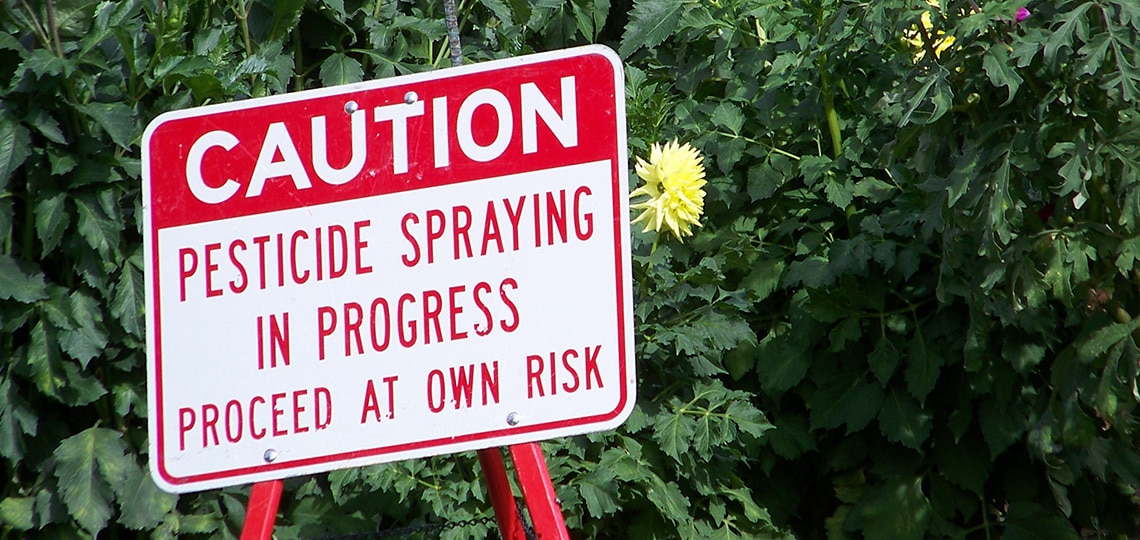Pesticides are toxic by design — their main purpose is to eliminate pests and weeds. It’s no surprise that when used, pesticides can profoundly impact human health and the environment.
That’s why for years, Ecojustice has worked to hold Health Canada accountable for its role in protecting people and the planet from pesticides. Most recently, we’ve submitted comments about the endocrine-disrupting chemical, atrazine. Endocrine-disruptors are chemicals that can mimic or interfere with the body’s hormones, also known as the endocrine system.
Atrazine is a herbicide registered for use in Canada on crops. It is used heavily in corn-growing regions of the country such as Quebec and Southern Ontario. Because of intensive use in these regions, it can be found in drinking water and in the Great Lakes.
In our submission on atrazine, we’re calling on Health Canada to:
- Be more open about how it monitors our exposure to atrazine in drinking water.
- Look at whether labeling is preventing the misuse of atrazine.
- Address the uncertainties around cancer risks and genotoxicity.
- Consider the well-documented damage atrazine can cause to aquatic plants and amphibians.
The bottom line is that heavy use of atrazine creates significant risks to both the aquatic ecosystem and human health. This isn’t this first time we’ve worked to put pressure on Health Canada to assess and act on the risks posed by atrazine.
In 2013, Ecojustice launched a lawsuit on behalf of the David Suzuki Foundation and Équiterre. The case led to a review of 23 pesticides banned in other countries, including atrazine. This then led to a special review of atrazine that was too narrow in scope. In 2017 the Pest Management Regulatory Agency (PMRA) started a second special review expanding the scope and has now published a proposal to continue to allow the use of atrazine.
Despite many jurisdictions banning atrazine, Canada continues to drag its feet
There are currently 13 products containing atrazine that can be used in Canada. They are often sprayed on corn crops in Ontario, Quebec and parts of Manitoba.
Frequently detected in raw and treated water, atrazine ends up in municipal drinking water. Many Canadians rely on surface water, including 81 per cent of Quebecers. This exposure is particularly alarming given atrazine’s links with cancer, reproductive problems and fetal development.
But even at low levels, atrazine can be dangerous.
American biologist Tyrone Hayes’s research found that when frogs were exposed to very low levels of atrazine — 0.1 parts per billion (ppb) — that it affected frogs’ reproductive systems. [1] In Canada, groundwater levels can be as high as 1496 μg/L (ppb) for atrazine and transformation products. And up to 107 μg/L (ppb) in surface water, well above the safe levels that Health Canada has defined for humans. Recent 2022 monitoring data confirms that it continues to be found in Nova Scotia, Prince Edward Island, Ontario, Quebec and Manitoba. In Ontario it is found at levels that exceed federal drinking water concentrations and levels that cause harm to the aquatic environment.
It’s clear that atrazine does not belong on the market and in the environment.
Atrazine under review (again), but what should Health Canada be looking at?
It has taken Health Canada almost twenty years to progress through various piecemeal reviews of atrazine in the wake of the European ban in 2004, and more recently the American restrictions to protect endangered species. Canada has also never referred the complex issues arising from atrazine to a panel of independent scientists.
Health Canada continues to ignore significant aquatic environmental and human cancer risks from atrazine. There is a vast body of evidence that shows atrazine to be detrimental to the environment. This pesticide has shown to change the sex of aquatic animals at low levels. It is an endocrine disruptor with potential links to several human cancers. Yet key published research demonstrating harm — including research used by other regulators — is not recognized in Canada.
In 2016 the US Environmental Protection Agency (EPA) published an ecological risk assessment that concluded that atrazine threatens the environment and aquatic ecological systems in areas of heavy use. [2] More recently, the EPA published an assessment of endangered species impacts which led to new restrictions on use in the US. The EPA is planning to convene another independent scientific advisory panel to study atrazine. Canada has set up a scientific advisory panel but has not referred any active ingredients to it for further study.
A legal mandate to protect our health and environment
This is not the only pesticide that Health Canada has dragged its feet on banning. We need to look no further than its actions on chlorpyrifos and glyphosate for examples.
Health Canada needs to step up and start protecting people and the environment from harmful pesticides. You can count on Ecojustice to continue to explore all avenues to make sure that happens.
Over the coming months, you can expect to see us challenging the registration of products, commenting on the reviews of existing pesticides and researching new pesticides on the market.
Updates were made on May 28, 2023, to the original The Hill Times piece published by Dr. Elaine MacDonald, Healthy Communities Program Director at Ecojustice, Muhannad Malas, Director of Law Reform at Ecojustice, Karen Ross, Pesticides and Toxics Project Manager at Équiterre and Kim Perrotta, executive director of the Canadian Association of Physicians.
References
[1] New report calls for atrazine review — Grist
[2] Refined Ecological Risk Assessment for Atrazine — Regulations.gov




